Organisational Cultural Safety Position Statement: Aged Care
VerifiedAdded on 2021/02/19
|9
|2597
|23
Report
AI Summary
This report provides a comprehensive analysis of an organizational cultural safety position statement, specifically focusing on aged care for Aboriginal and Torres Strait Islander populations within the context of the Royal Melbourne Hospital. The report defines cultural safety and its importance in creating a safe healthcare environment, emphasizing the need for effective communication and health literacy. It explores the relationship between these elements and the external influences that can either contribute to or detract from culturally safe practices. Furthermore, the report examines how the organization can improve health outcomes for its target clients and identifies potential barriers to implementing the position statement. The report highlights the significance of addressing social, cultural, and historical factors, and emphasizes the need for a system-wide approach to ensure culturally competent care, ultimately aiming to improve access to and the quality of healthcare services for the indigenous community.

ORGANISATIONAL
CULTURAL SAFETY
POSITION STATEMENT
CULTURAL SAFETY
POSITION STATEMENT
Paraphrase This Document
Need a fresh take? Get an instant paraphrase of this document with our AI Paraphraser
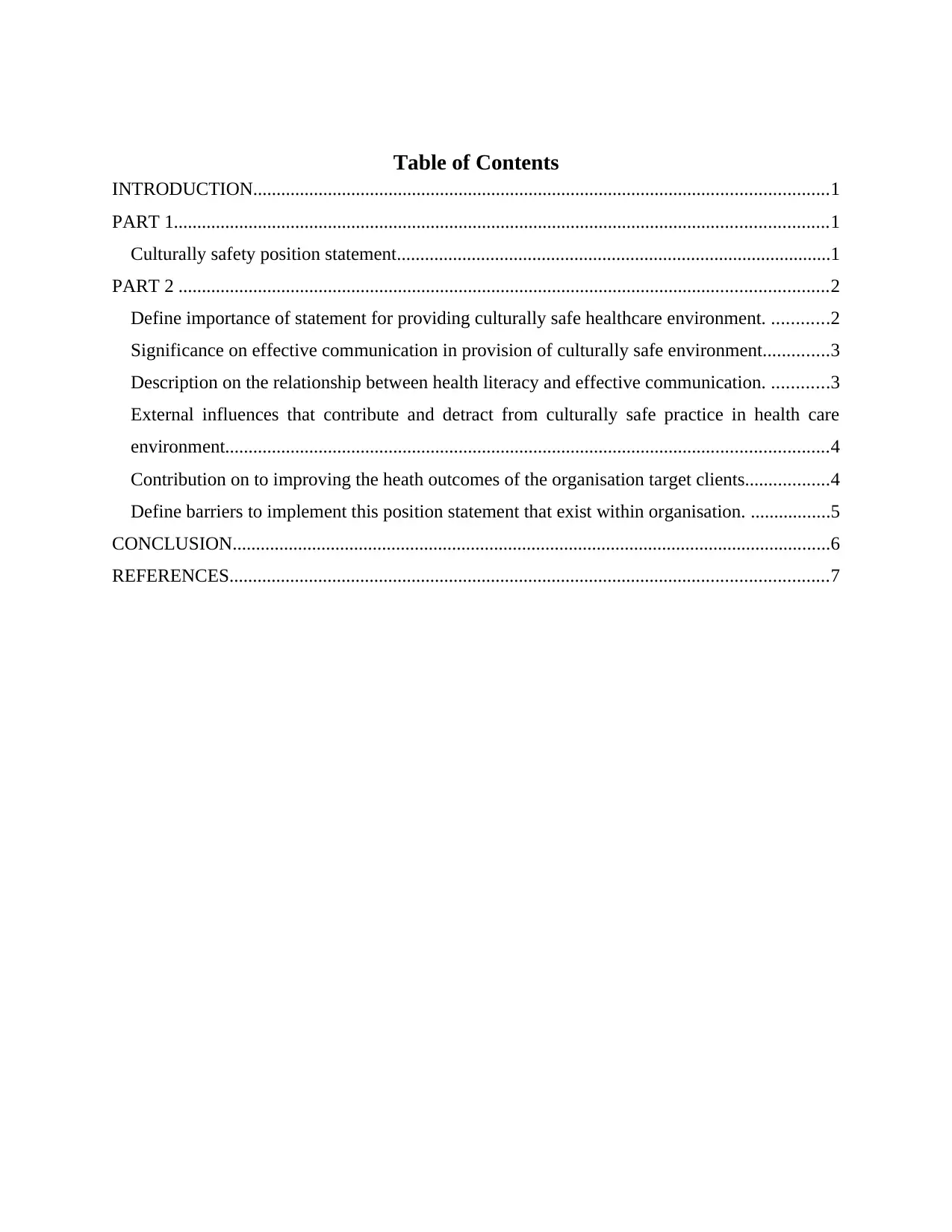
Table of Contents
INTRODUCTION...........................................................................................................................1
PART 1............................................................................................................................................1
Culturally safety position statement.............................................................................................1
PART 2 ...........................................................................................................................................2
Define importance of statement for providing culturally safe healthcare environment. ............2
Significance on effective communication in provision of culturally safe environment..............3
Description on the relationship between health literacy and effective communication. ............3
External influences that contribute and detract from culturally safe practice in health care
environment.................................................................................................................................4
Contribution on to improving the heath outcomes of the organisation target clients..................4
Define barriers to implement this position statement that exist within organisation. .................5
CONCLUSION................................................................................................................................6
REFERENCES................................................................................................................................7
INTRODUCTION...........................................................................................................................1
PART 1............................................................................................................................................1
Culturally safety position statement.............................................................................................1
PART 2 ...........................................................................................................................................2
Define importance of statement for providing culturally safe healthcare environment. ............2
Significance on effective communication in provision of culturally safe environment..............3
Description on the relationship between health literacy and effective communication. ............3
External influences that contribute and detract from culturally safe practice in health care
environment.................................................................................................................................4
Contribution on to improving the heath outcomes of the organisation target clients..................4
Define barriers to implement this position statement that exist within organisation. .................5
CONCLUSION................................................................................................................................6
REFERENCES................................................................................................................................7
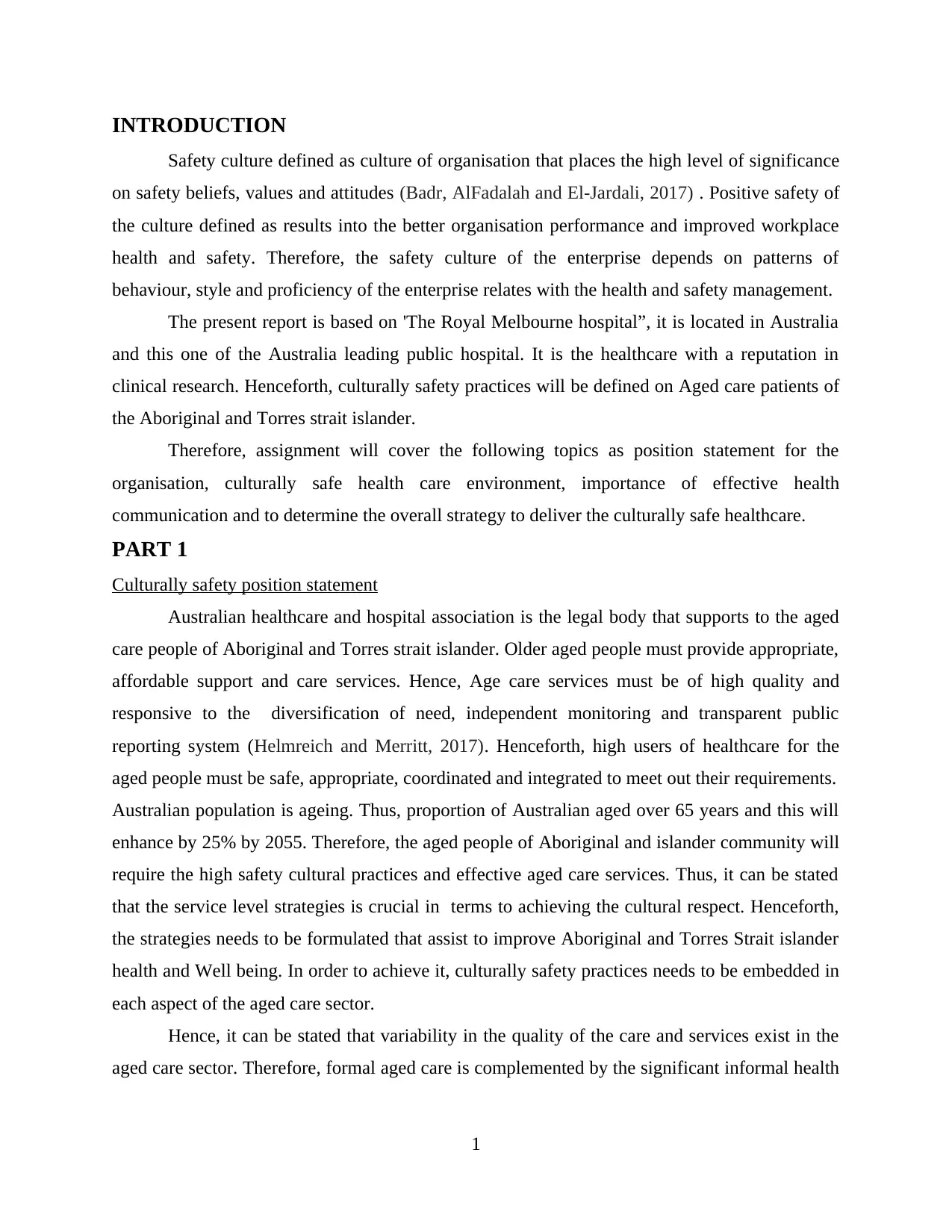
INTRODUCTION
Safety culture defined as culture of organisation that places the high level of significance
on safety beliefs, values and attitudes (Badr, AlFadalah and El-Jardali, 2017) . Positive safety of
the culture defined as results into the better organisation performance and improved workplace
health and safety. Therefore, the safety culture of the enterprise depends on patterns of
behaviour, style and proficiency of the enterprise relates with the health and safety management.
The present report is based on 'The Royal Melbourne hospital”, it is located in Australia
and this one of the Australia leading public hospital. It is the healthcare with a reputation in
clinical research. Henceforth, culturally safety practices will be defined on Aged care patients of
the Aboriginal and Torres strait islander.
Therefore, assignment will cover the following topics as position statement for the
organisation, culturally safe health care environment, importance of effective health
communication and to determine the overall strategy to deliver the culturally safe healthcare.
PART 1
Culturally safety position statement
Australian healthcare and hospital association is the legal body that supports to the aged
care people of Aboriginal and Torres strait islander. Older aged people must provide appropriate,
affordable support and care services. Hence, Age care services must be of high quality and
responsive to the diversification of need, independent monitoring and transparent public
reporting system (Helmreich and Merritt, 2017). Henceforth, high users of healthcare for the
aged people must be safe, appropriate, coordinated and integrated to meet out their requirements.
Australian population is ageing. Thus, proportion of Australian aged over 65 years and this will
enhance by 25% by 2055. Therefore, the aged people of Aboriginal and islander community will
require the high safety cultural practices and effective aged care services. Thus, it can be stated
that the service level strategies is crucial in terms to achieving the cultural respect. Henceforth,
the strategies needs to be formulated that assist to improve Aboriginal and Torres Strait islander
health and Well being. In order to achieve it, culturally safety practices needs to be embedded in
each aspect of the aged care sector.
Hence, it can be stated that variability in the quality of the care and services exist in the
aged care sector. Therefore, formal aged care is complemented by the significant informal health
1
Safety culture defined as culture of organisation that places the high level of significance
on safety beliefs, values and attitudes (Badr, AlFadalah and El-Jardali, 2017) . Positive safety of
the culture defined as results into the better organisation performance and improved workplace
health and safety. Therefore, the safety culture of the enterprise depends on patterns of
behaviour, style and proficiency of the enterprise relates with the health and safety management.
The present report is based on 'The Royal Melbourne hospital”, it is located in Australia
and this one of the Australia leading public hospital. It is the healthcare with a reputation in
clinical research. Henceforth, culturally safety practices will be defined on Aged care patients of
the Aboriginal and Torres strait islander.
Therefore, assignment will cover the following topics as position statement for the
organisation, culturally safe health care environment, importance of effective health
communication and to determine the overall strategy to deliver the culturally safe healthcare.
PART 1
Culturally safety position statement
Australian healthcare and hospital association is the legal body that supports to the aged
care people of Aboriginal and Torres strait islander. Older aged people must provide appropriate,
affordable support and care services. Hence, Age care services must be of high quality and
responsive to the diversification of need, independent monitoring and transparent public
reporting system (Helmreich and Merritt, 2017). Henceforth, high users of healthcare for the
aged people must be safe, appropriate, coordinated and integrated to meet out their requirements.
Australian population is ageing. Thus, proportion of Australian aged over 65 years and this will
enhance by 25% by 2055. Therefore, the aged people of Aboriginal and islander community will
require the high safety cultural practices and effective aged care services. Thus, it can be stated
that the service level strategies is crucial in terms to achieving the cultural respect. Henceforth,
the strategies needs to be formulated that assist to improve Aboriginal and Torres Strait islander
health and Well being. In order to achieve it, culturally safety practices needs to be embedded in
each aspect of the aged care sector.
Hence, it can be stated that variability in the quality of the care and services exist in the
aged care sector. Therefore, formal aged care is complemented by the significant informal health
1
⊘ This is a preview!⊘
Do you want full access?
Subscribe today to unlock all pages.

Trusted by 1+ million students worldwide
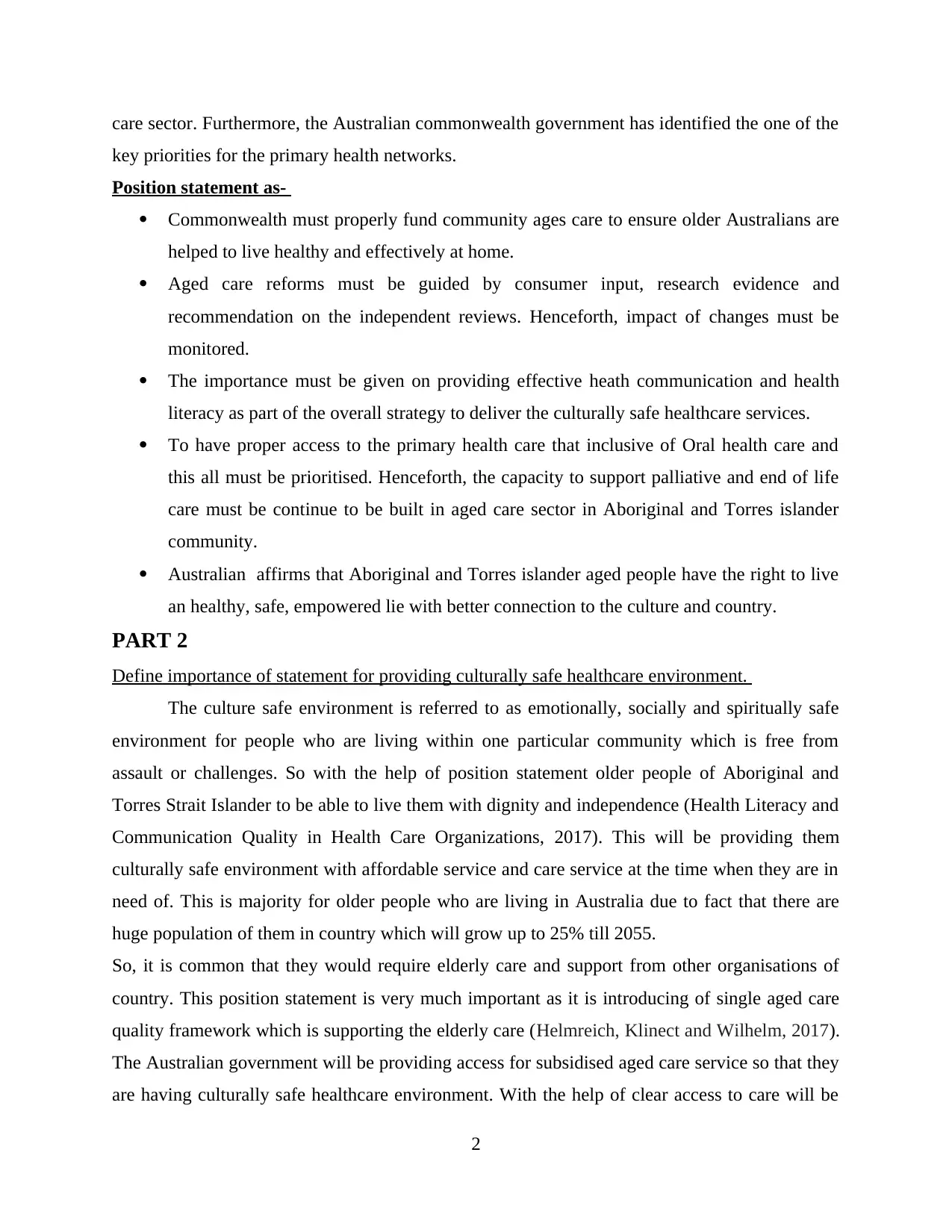
care sector. Furthermore, the Australian commonwealth government has identified the one of the
key priorities for the primary health networks.
Position statement as-
Commonwealth must properly fund community ages care to ensure older Australians are
helped to live healthy and effectively at home.
Aged care reforms must be guided by consumer input, research evidence and
recommendation on the independent reviews. Henceforth, impact of changes must be
monitored.
The importance must be given on providing effective heath communication and health
literacy as part of the overall strategy to deliver the culturally safe healthcare services.
To have proper access to the primary health care that inclusive of Oral health care and
this all must be prioritised. Henceforth, the capacity to support palliative and end of life
care must be continue to be built in aged care sector in Aboriginal and Torres islander
community.
Australian affirms that Aboriginal and Torres islander aged people have the right to live
an healthy, safe, empowered lie with better connection to the culture and country.
PART 2
Define importance of statement for providing culturally safe healthcare environment.
The culture safe environment is referred to as emotionally, socially and spiritually safe
environment for people who are living within one particular community which is free from
assault or challenges. So with the help of position statement older people of Aboriginal and
Torres Strait Islander to be able to live them with dignity and independence (Health Literacy and
Communication Quality in Health Care Organizations, 2017). This will be providing them
culturally safe environment with affordable service and care service at the time when they are in
need of. This is majority for older people who are living in Australia due to fact that there are
huge population of them in country which will grow up to 25% till 2055.
So, it is common that they would require elderly care and support from other organisations of
country. This position statement is very much important as it is introducing of single aged care
quality framework which is supporting the elderly care (Helmreich, Klinect and Wilhelm, 2017).
The Australian government will be providing access for subsidised aged care service so that they
are having culturally safe healthcare environment. With the help of clear access to care will be
2
key priorities for the primary health networks.
Position statement as-
Commonwealth must properly fund community ages care to ensure older Australians are
helped to live healthy and effectively at home.
Aged care reforms must be guided by consumer input, research evidence and
recommendation on the independent reviews. Henceforth, impact of changes must be
monitored.
The importance must be given on providing effective heath communication and health
literacy as part of the overall strategy to deliver the culturally safe healthcare services.
To have proper access to the primary health care that inclusive of Oral health care and
this all must be prioritised. Henceforth, the capacity to support palliative and end of life
care must be continue to be built in aged care sector in Aboriginal and Torres islander
community.
Australian affirms that Aboriginal and Torres islander aged people have the right to live
an healthy, safe, empowered lie with better connection to the culture and country.
PART 2
Define importance of statement for providing culturally safe healthcare environment.
The culture safe environment is referred to as emotionally, socially and spiritually safe
environment for people who are living within one particular community which is free from
assault or challenges. So with the help of position statement older people of Aboriginal and
Torres Strait Islander to be able to live them with dignity and independence (Health Literacy and
Communication Quality in Health Care Organizations, 2017). This will be providing them
culturally safe environment with affordable service and care service at the time when they are in
need of. This is majority for older people who are living in Australia due to fact that there are
huge population of them in country which will grow up to 25% till 2055.
So, it is common that they would require elderly care and support from other organisations of
country. This position statement is very much important as it is introducing of single aged care
quality framework which is supporting the elderly care (Helmreich, Klinect and Wilhelm, 2017).
The Australian government will be providing access for subsidised aged care service so that they
are having culturally safe healthcare environment. With the help of clear access to care will be
2
Paraphrase This Document
Need a fresh take? Get an instant paraphrase of this document with our AI Paraphraser
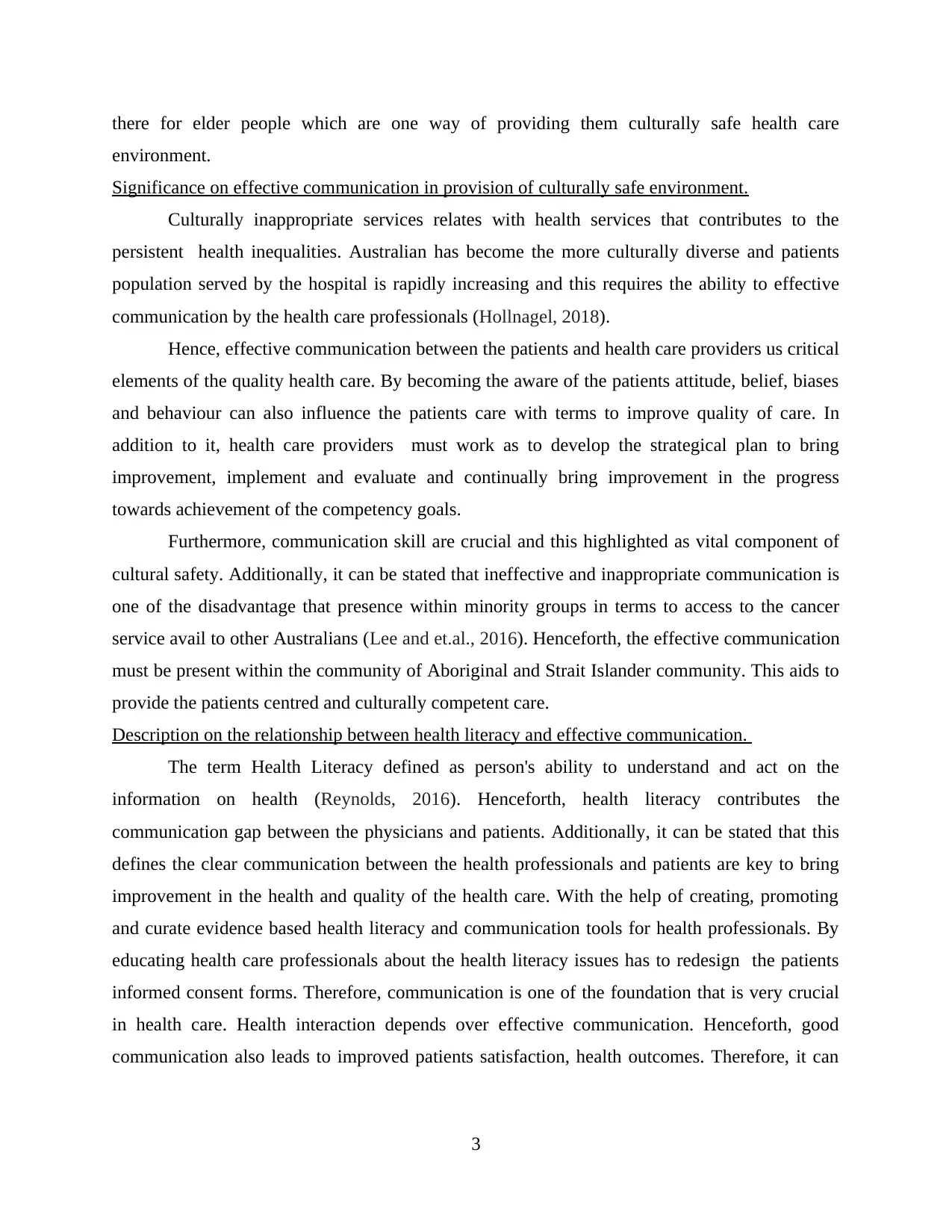
there for elder people which are one way of providing them culturally safe health care
environment.
Significance on effective communication in provision of culturally safe environment.
Culturally inappropriate services relates with health services that contributes to the
persistent health inequalities. Australian has become the more culturally diverse and patients
population served by the hospital is rapidly increasing and this requires the ability to effective
communication by the health care professionals (Hollnagel, 2018).
Hence, effective communication between the patients and health care providers us critical
elements of the quality health care. By becoming the aware of the patients attitude, belief, biases
and behaviour can also influence the patients care with terms to improve quality of care. In
addition to it, health care providers must work as to develop the strategical plan to bring
improvement, implement and evaluate and continually bring improvement in the progress
towards achievement of the competency goals.
Furthermore, communication skill are crucial and this highlighted as vital component of
cultural safety. Additionally, it can be stated that ineffective and inappropriate communication is
one of the disadvantage that presence within minority groups in terms to access to the cancer
service avail to other Australians (Lee and et.al., 2016). Henceforth, the effective communication
must be present within the community of Aboriginal and Strait Islander community. This aids to
provide the patients centred and culturally competent care.
Description on the relationship between health literacy and effective communication.
The term Health Literacy defined as person's ability to understand and act on the
information on health (Reynolds, 2016). Henceforth, health literacy contributes the
communication gap between the physicians and patients. Additionally, it can be stated that this
defines the clear communication between the health professionals and patients are key to bring
improvement in the health and quality of the health care. With the help of creating, promoting
and curate evidence based health literacy and communication tools for health professionals. By
educating health care professionals about the health literacy issues has to redesign the patients
informed consent forms. Therefore, communication is one of the foundation that is very crucial
in health care. Health interaction depends over effective communication. Henceforth, good
communication also leads to improved patients satisfaction, health outcomes. Therefore, it can
3
environment.
Significance on effective communication in provision of culturally safe environment.
Culturally inappropriate services relates with health services that contributes to the
persistent health inequalities. Australian has become the more culturally diverse and patients
population served by the hospital is rapidly increasing and this requires the ability to effective
communication by the health care professionals (Hollnagel, 2018).
Hence, effective communication between the patients and health care providers us critical
elements of the quality health care. By becoming the aware of the patients attitude, belief, biases
and behaviour can also influence the patients care with terms to improve quality of care. In
addition to it, health care providers must work as to develop the strategical plan to bring
improvement, implement and evaluate and continually bring improvement in the progress
towards achievement of the competency goals.
Furthermore, communication skill are crucial and this highlighted as vital component of
cultural safety. Additionally, it can be stated that ineffective and inappropriate communication is
one of the disadvantage that presence within minority groups in terms to access to the cancer
service avail to other Australians (Lee and et.al., 2016). Henceforth, the effective communication
must be present within the community of Aboriginal and Strait Islander community. This aids to
provide the patients centred and culturally competent care.
Description on the relationship between health literacy and effective communication.
The term Health Literacy defined as person's ability to understand and act on the
information on health (Reynolds, 2016). Henceforth, health literacy contributes the
communication gap between the physicians and patients. Additionally, it can be stated that this
defines the clear communication between the health professionals and patients are key to bring
improvement in the health and quality of the health care. With the help of creating, promoting
and curate evidence based health literacy and communication tools for health professionals. By
educating health care professionals about the health literacy issues has to redesign the patients
informed consent forms. Therefore, communication is one of the foundation that is very crucial
in health care. Health interaction depends over effective communication. Henceforth, good
communication also leads to improved patients satisfaction, health outcomes. Therefore, it can
3
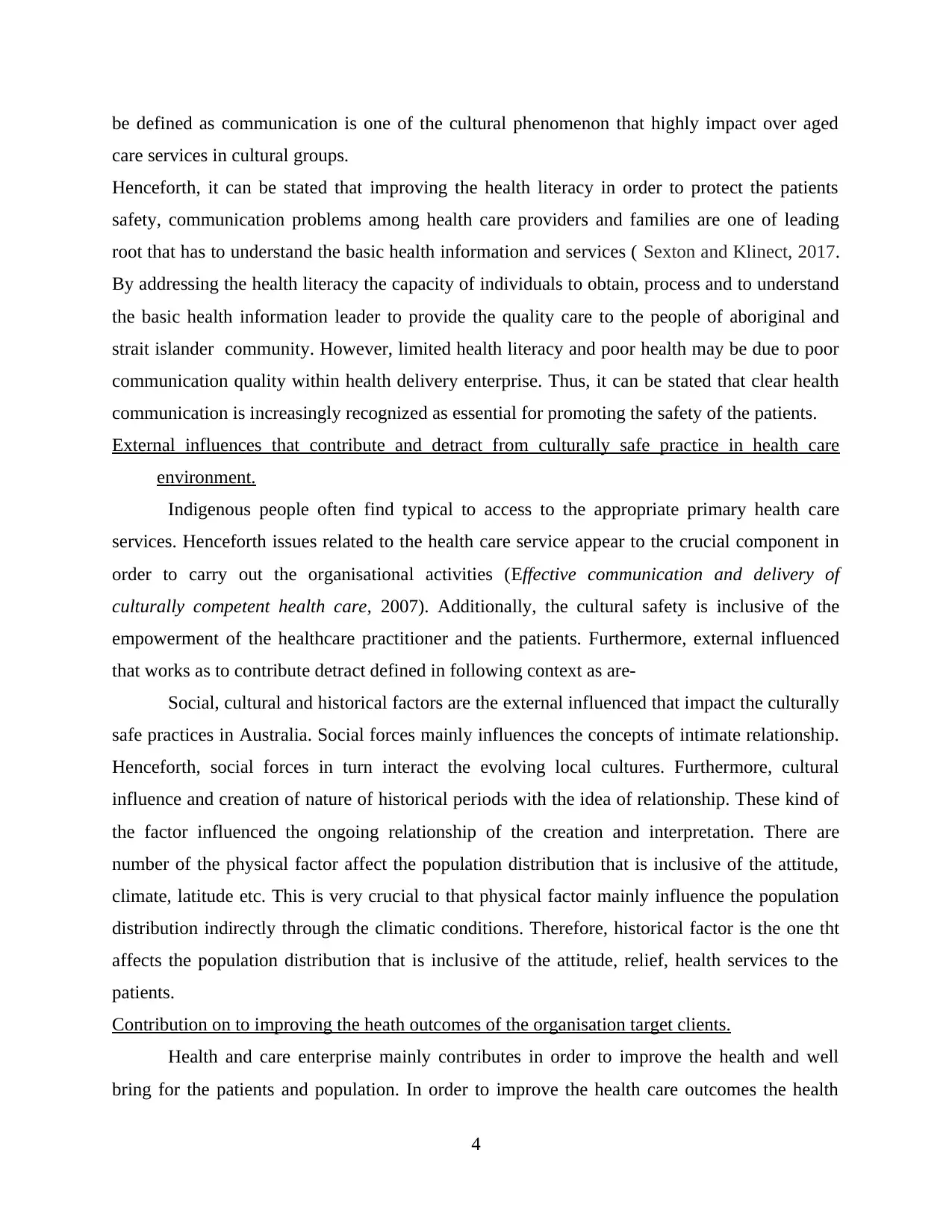
be defined as communication is one of the cultural phenomenon that highly impact over aged
care services in cultural groups.
Henceforth, it can be stated that improving the health literacy in order to protect the patients
safety, communication problems among health care providers and families are one of leading
root that has to understand the basic health information and services ( Sexton and Klinect, 2017.
By addressing the health literacy the capacity of individuals to obtain, process and to understand
the basic health information leader to provide the quality care to the people of aboriginal and
strait islander community. However, limited health literacy and poor health may be due to poor
communication quality within health delivery enterprise. Thus, it can be stated that clear health
communication is increasingly recognized as essential for promoting the safety of the patients.
External influences that contribute and detract from culturally safe practice in health care
environment.
Indigenous people often find typical to access to the appropriate primary health care
services. Henceforth issues related to the health care service appear to the crucial component in
order to carry out the organisational activities (Effective communication and delivery of
culturally competent health care, 2007). Additionally, the cultural safety is inclusive of the
empowerment of the healthcare practitioner and the patients. Furthermore, external influenced
that works as to contribute detract defined in following context as are-
Social, cultural and historical factors are the external influenced that impact the culturally
safe practices in Australia. Social forces mainly influences the concepts of intimate relationship.
Henceforth, social forces in turn interact the evolving local cultures. Furthermore, cultural
influence and creation of nature of historical periods with the idea of relationship. These kind of
the factor influenced the ongoing relationship of the creation and interpretation. There are
number of the physical factor affect the population distribution that is inclusive of the attitude,
climate, latitude etc. This is very crucial to that physical factor mainly influence the population
distribution indirectly through the climatic conditions. Therefore, historical factor is the one tht
affects the population distribution that is inclusive of the attitude, relief, health services to the
patients.
Contribution on to improving the heath outcomes of the organisation target clients.
Health and care enterprise mainly contributes in order to improve the health and well
bring for the patients and population. In order to improve the health care outcomes the health
4
care services in cultural groups.
Henceforth, it can be stated that improving the health literacy in order to protect the patients
safety, communication problems among health care providers and families are one of leading
root that has to understand the basic health information and services ( Sexton and Klinect, 2017.
By addressing the health literacy the capacity of individuals to obtain, process and to understand
the basic health information leader to provide the quality care to the people of aboriginal and
strait islander community. However, limited health literacy and poor health may be due to poor
communication quality within health delivery enterprise. Thus, it can be stated that clear health
communication is increasingly recognized as essential for promoting the safety of the patients.
External influences that contribute and detract from culturally safe practice in health care
environment.
Indigenous people often find typical to access to the appropriate primary health care
services. Henceforth issues related to the health care service appear to the crucial component in
order to carry out the organisational activities (Effective communication and delivery of
culturally competent health care, 2007). Additionally, the cultural safety is inclusive of the
empowerment of the healthcare practitioner and the patients. Furthermore, external influenced
that works as to contribute detract defined in following context as are-
Social, cultural and historical factors are the external influenced that impact the culturally
safe practices in Australia. Social forces mainly influences the concepts of intimate relationship.
Henceforth, social forces in turn interact the evolving local cultures. Furthermore, cultural
influence and creation of nature of historical periods with the idea of relationship. These kind of
the factor influenced the ongoing relationship of the creation and interpretation. There are
number of the physical factor affect the population distribution that is inclusive of the attitude,
climate, latitude etc. This is very crucial to that physical factor mainly influence the population
distribution indirectly through the climatic conditions. Therefore, historical factor is the one tht
affects the population distribution that is inclusive of the attitude, relief, health services to the
patients.
Contribution on to improving the heath outcomes of the organisation target clients.
Health and care enterprise mainly contributes in order to improve the health and well
bring for the patients and population. In order to improve the health care outcomes the health
4
⊘ This is a preview!⊘
Do you want full access?
Subscribe today to unlock all pages.

Trusted by 1+ million students worldwide
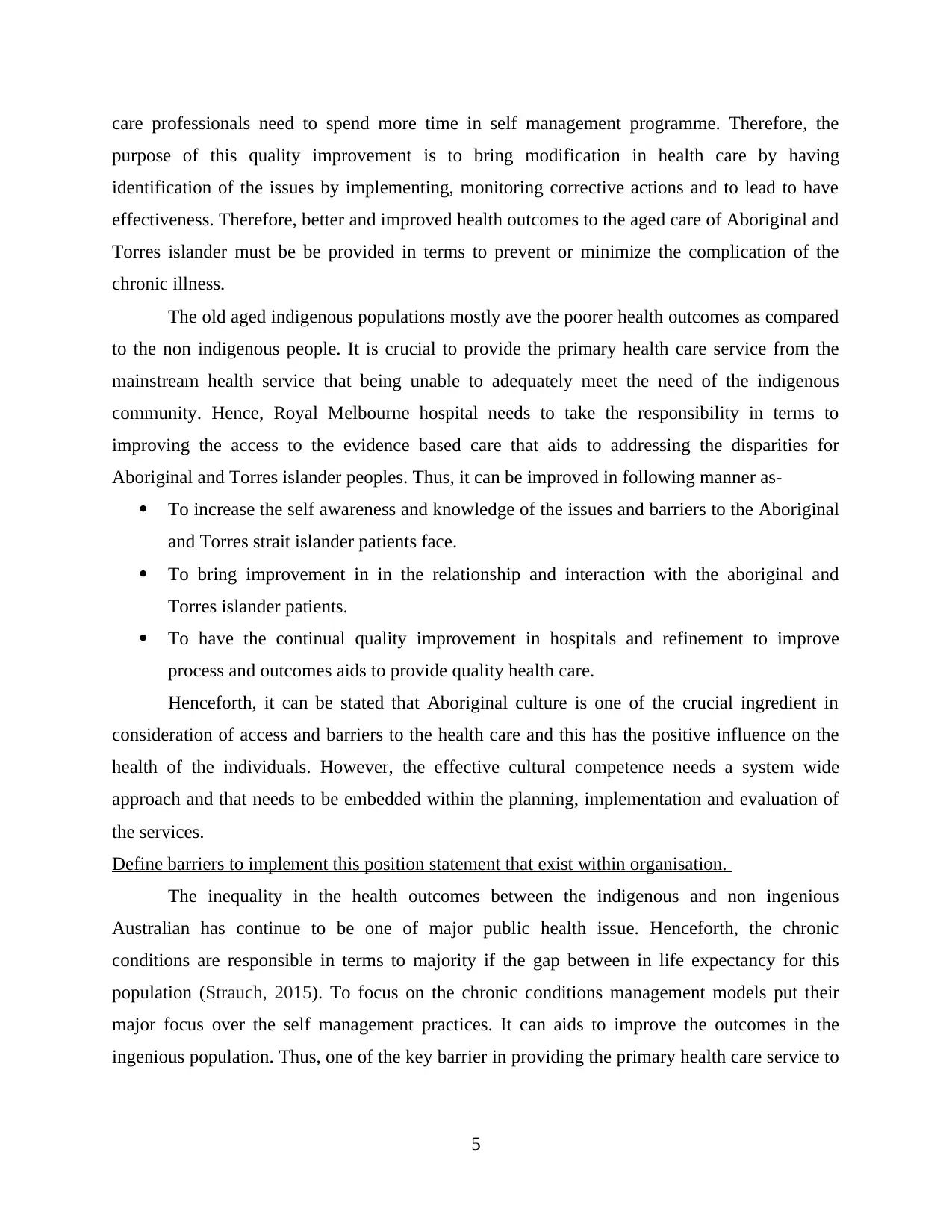
care professionals need to spend more time in self management programme. Therefore, the
purpose of this quality improvement is to bring modification in health care by having
identification of the issues by implementing, monitoring corrective actions and to lead to have
effectiveness. Therefore, better and improved health outcomes to the aged care of Aboriginal and
Torres islander must be be provided in terms to prevent or minimize the complication of the
chronic illness.
The old aged indigenous populations mostly ave the poorer health outcomes as compared
to the non indigenous people. It is crucial to provide the primary health care service from the
mainstream health service that being unable to adequately meet the need of the indigenous
community. Hence, Royal Melbourne hospital needs to take the responsibility in terms to
improving the access to the evidence based care that aids to addressing the disparities for
Aboriginal and Torres islander peoples. Thus, it can be improved in following manner as-
To increase the self awareness and knowledge of the issues and barriers to the Aboriginal
and Torres strait islander patients face.
To bring improvement in in the relationship and interaction with the aboriginal and
Torres islander patients.
To have the continual quality improvement in hospitals and refinement to improve
process and outcomes aids to provide quality health care.
Henceforth, it can be stated that Aboriginal culture is one of the crucial ingredient in
consideration of access and barriers to the health care and this has the positive influence on the
health of the individuals. However, the effective cultural competence needs a system wide
approach and that needs to be embedded within the planning, implementation and evaluation of
the services.
Define barriers to implement this position statement that exist within organisation.
The inequality in the health outcomes between the indigenous and non ingenious
Australian has continue to be one of major public health issue. Henceforth, the chronic
conditions are responsible in terms to majority if the gap between in life expectancy for this
population (Strauch, 2015). To focus on the chronic conditions management models put their
major focus over the self management practices. It can aids to improve the outcomes in the
ingenious population. Thus, one of the key barrier in providing the primary health care service to
5
purpose of this quality improvement is to bring modification in health care by having
identification of the issues by implementing, monitoring corrective actions and to lead to have
effectiveness. Therefore, better and improved health outcomes to the aged care of Aboriginal and
Torres islander must be be provided in terms to prevent or minimize the complication of the
chronic illness.
The old aged indigenous populations mostly ave the poorer health outcomes as compared
to the non indigenous people. It is crucial to provide the primary health care service from the
mainstream health service that being unable to adequately meet the need of the indigenous
community. Hence, Royal Melbourne hospital needs to take the responsibility in terms to
improving the access to the evidence based care that aids to addressing the disparities for
Aboriginal and Torres islander peoples. Thus, it can be improved in following manner as-
To increase the self awareness and knowledge of the issues and barriers to the Aboriginal
and Torres strait islander patients face.
To bring improvement in in the relationship and interaction with the aboriginal and
Torres islander patients.
To have the continual quality improvement in hospitals and refinement to improve
process and outcomes aids to provide quality health care.
Henceforth, it can be stated that Aboriginal culture is one of the crucial ingredient in
consideration of access and barriers to the health care and this has the positive influence on the
health of the individuals. However, the effective cultural competence needs a system wide
approach and that needs to be embedded within the planning, implementation and evaluation of
the services.
Define barriers to implement this position statement that exist within organisation.
The inequality in the health outcomes between the indigenous and non ingenious
Australian has continue to be one of major public health issue. Henceforth, the chronic
conditions are responsible in terms to majority if the gap between in life expectancy for this
population (Strauch, 2015). To focus on the chronic conditions management models put their
major focus over the self management practices. It can aids to improve the outcomes in the
ingenious population. Thus, one of the key barrier in providing the primary health care service to
5
Paraphrase This Document
Need a fresh take? Get an instant paraphrase of this document with our AI Paraphraser
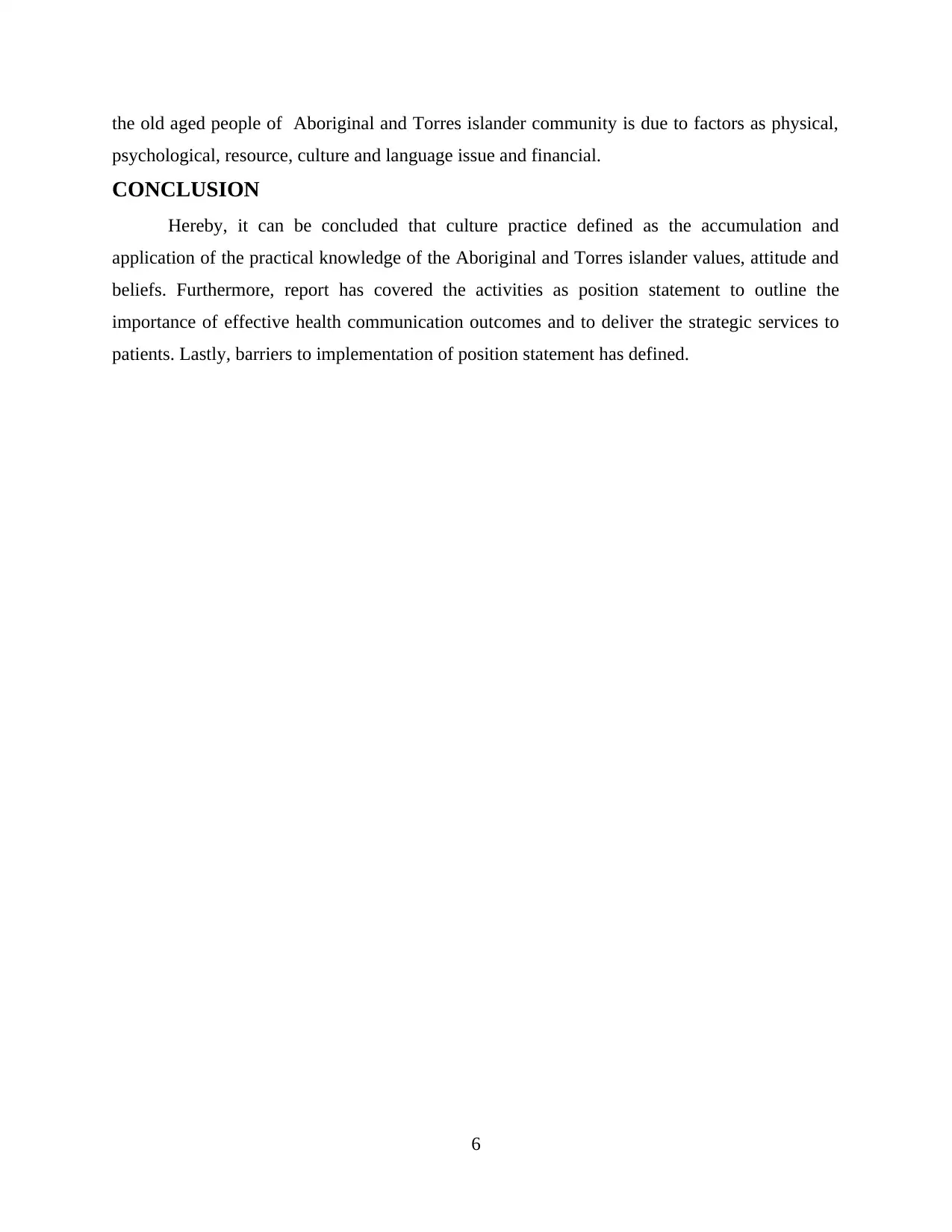
the old aged people of Aboriginal and Torres islander community is due to factors as physical,
psychological, resource, culture and language issue and financial.
CONCLUSION
Hereby, it can be concluded that culture practice defined as the accumulation and
application of the practical knowledge of the Aboriginal and Torres islander values, attitude and
beliefs. Furthermore, report has covered the activities as position statement to outline the
importance of effective health communication outcomes and to deliver the strategic services to
patients. Lastly, barriers to implementation of position statement has defined.
6
psychological, resource, culture and language issue and financial.
CONCLUSION
Hereby, it can be concluded that culture practice defined as the accumulation and
application of the practical knowledge of the Aboriginal and Torres islander values, attitude and
beliefs. Furthermore, report has covered the activities as position statement to outline the
importance of effective health communication outcomes and to deliver the strategic services to
patients. Lastly, barriers to implementation of position statement has defined.
6
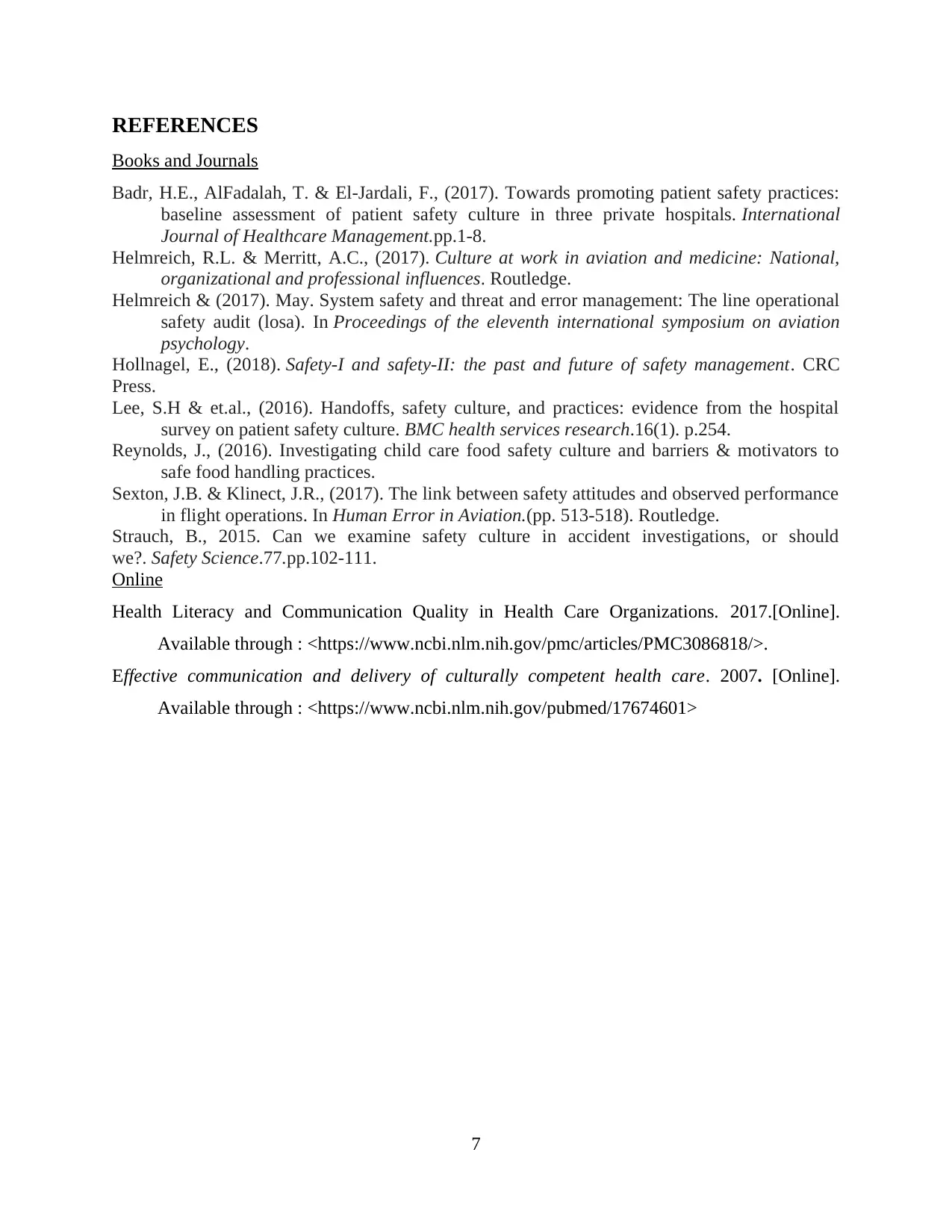
REFERENCES
Books and Journals
Badr, H.E., AlFadalah, T. & El-Jardali, F., (2017). Towards promoting patient safety practices:
baseline assessment of patient safety culture in three private hospitals. International
Journal of Healthcare Management.pp.1-8.
Helmreich, R.L. & Merritt, A.C., (2017). Culture at work in aviation and medicine: National,
organizational and professional influences. Routledge.
Helmreich & (2017). May. System safety and threat and error management: The line operational
safety audit (losa). In Proceedings of the eleventh international symposium on aviation
psychology.
Hollnagel, E., (2018). Safety-I and safety-II: the past and future of safety management. CRC
Press.
Lee, S.H & et.al., (2016). Handoffs, safety culture, and practices: evidence from the hospital
survey on patient safety culture. BMC health services research.16(1). p.254.
Reynolds, J., (2016). Investigating child care food safety culture and barriers & motivators to
safe food handling practices.
Sexton, J.B. & Klinect, J.R., (2017). The link between safety attitudes and observed performance
in flight operations. In Human Error in Aviation.(pp. 513-518). Routledge.
Strauch, B., 2015. Can we examine safety culture in accident investigations, or should
we?. Safety Science.77.pp.102-111.
Online
Health Literacy and Communication Quality in Health Care Organizations. 2017.[Online].
Available through : <https://www.ncbi.nlm.nih.gov/pmc/articles/PMC3086818/>.
Effective communication and delivery of culturally competent health care. 2007. [Online].
Available through : <https://www.ncbi.nlm.nih.gov/pubmed/17674601>
7
Books and Journals
Badr, H.E., AlFadalah, T. & El-Jardali, F., (2017). Towards promoting patient safety practices:
baseline assessment of patient safety culture in three private hospitals. International
Journal of Healthcare Management.pp.1-8.
Helmreich, R.L. & Merritt, A.C., (2017). Culture at work in aviation and medicine: National,
organizational and professional influences. Routledge.
Helmreich & (2017). May. System safety and threat and error management: The line operational
safety audit (losa). In Proceedings of the eleventh international symposium on aviation
psychology.
Hollnagel, E., (2018). Safety-I and safety-II: the past and future of safety management. CRC
Press.
Lee, S.H & et.al., (2016). Handoffs, safety culture, and practices: evidence from the hospital
survey on patient safety culture. BMC health services research.16(1). p.254.
Reynolds, J., (2016). Investigating child care food safety culture and barriers & motivators to
safe food handling practices.
Sexton, J.B. & Klinect, J.R., (2017). The link between safety attitudes and observed performance
in flight operations. In Human Error in Aviation.(pp. 513-518). Routledge.
Strauch, B., 2015. Can we examine safety culture in accident investigations, or should
we?. Safety Science.77.pp.102-111.
Online
Health Literacy and Communication Quality in Health Care Organizations. 2017.[Online].
Available through : <https://www.ncbi.nlm.nih.gov/pmc/articles/PMC3086818/>.
Effective communication and delivery of culturally competent health care. 2007. [Online].
Available through : <https://www.ncbi.nlm.nih.gov/pubmed/17674601>
7
⊘ This is a preview!⊘
Do you want full access?
Subscribe today to unlock all pages.

Trusted by 1+ million students worldwide
1 out of 9
Related Documents
Your All-in-One AI-Powered Toolkit for Academic Success.
+13062052269
info@desklib.com
Available 24*7 on WhatsApp / Email
![[object Object]](/_next/static/media/star-bottom.7253800d.svg)
Unlock your academic potential
Copyright © 2020–2026 A2Z Services. All Rights Reserved. Developed and managed by ZUCOL.





